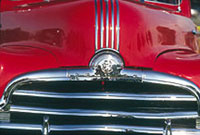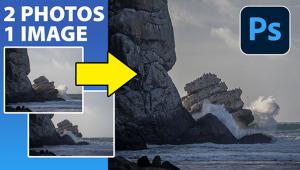Cruisin Power
10 Tips For Classic Car Images
A large percentage of the population has always had a love affair with the automobile. We own more cars per capita than any other culture and we have a genuine fascination with older models. When "classic" vehicles reach a certain age, some will spend small fortunes restoring them. They place the very finest samples in museums for millions of us to admire. The '56 T-bird, the '65 Mustang, the '57 Chevy, and many more will never disappear thanks to a population which appreciates their beauty. For the photo enthusiast, classic cars can make for an excellent subject. Most every weekend, all across the continent, car collectors regularly display their vehicles to an admiring public. Do a bit of research and you'll find many shows, club meets, and Cruisin' events providing a wealth of photo opportunities. For images you'll be proud to show or hang on a wall, consider some of the following tips for getting high impact photos. |
|||
1. Try A Wide Angle Lens. In order to minimize the frustration of trying to shoot around crowds of spectators, arrive early. If the scheduled start time is 9am, be there by 8:30. (Sunday mornings are usually the least crowded.) For at least an hour, you won't need to worry about crowds. And before all of the cars arrive, they won't all be packed in like sardines. Isolating a red Lotus against a grassy or treed background will be relatively easy. This is the time to use a 28-70mm or 20-35mm zoom for the full-body glamour shots we see on calendars and magazine covers. (Naturally, this only works in picturesque locations.) In close-ups, the short focal lengths can produce exaggerated perspective which appears "unnatural"; consider this carefully unless intentionally striving for an unusual effect. If there are fences or booths full of vendors, try to find the least cluttered section of the area. Begin shooting as soon as an interesting vehicle arrives, paying close attention to the background. 2. Use A Normal Lens. Eventually, the entire area will be packed with cars and people, making wide angle photography impractical. You simply will not be able to avoid including spectators and other vehicles in the background. Focal lengths around 50mm can still be useful if you move in close. Record only the side of a car, or only the front, excluding extraneous elements. Or get very low to the ground and use the sky as a background. For example, isolate the bumper and grille area of a crimson TR-4 with a British license plate against a rich, blue background of polarized sky. |
|||
3. Shoot Details. Switch to a 70-210mm or 100-300mm "macro" zoom and shoot tighter close-ups. Look for small details that characterize the year, make, and model. Badges and logos, chrome engine parts with colorful hoses, unique grilles, wheels with wooden spokes, and chromed lamps are but a few examples. Shoot abstracts, too, emphasizing sensuous curves, geometric lines, or the contrast of sparkling chrome on gleaming sheet metal. Personal favorites include the reflections of a car in a chrome hub cap and an interesting hood ornament reflecting in glossy paint work. Both call for small apertures such as f/11 or f/16 for adequate depth of field (so the entire subject is within the range of sharp focus). On sunny days, I look for specular highlights on shiny chrome: points of bright, reflected light. At f/16 to f/32 these are rendered with a star effect, producing a very pleasing accent. Unless you're using an ISO 400 film the techniques mentioned will require a firm support to avoid blur from camera shake at the longer shutter speeds. Before the crowds get too heavy, you can conveniently use a tripod, ideal for razor sharp images and for precise composition. |
|||
4. Avoid Underexposure. If you rely on the in-camera light meter to automatically produce good exposures, many of your images will be disappointing. Especially on sunny days, the bright reflections from glossy paint work and chrome will often lead to underexposure. With slide film, expect a lot of rejects. If shooting color negative film, the lab can compensate when making prints, but the results will not always be perfect. Color print film benefits from some overexposure: for richer colors and finer grain. With negative film, a +1 exposure compensation factor is a fairly good compromise for good prints in most pictures including cars, unless they are very dark in color. With slide film, you'll need to think about each situation individually. When a cream-colored 'Vette fills the frame, try a +1 or +1.5 EV factor. For medium-tone pastels, a +0.5 to +1 setting should be adequate. If you're using one of the "intelligent" systems mentioned earlier, it may automatically compensate for subjects with extreme highlight areas. In that case, you may not need to override the meter. Frankly, it's a lot easier to take the meter reading from a known mid tone and use that as the starting point. Take the meter reading from grass--in exactly the same light as the subject. Hold the resulting settings with AE Lock in Automatic, or in the camera's Manual mode, while you recompose and trip the shutter. Note: Experience indicates that with slide film--with a light toned subject--you get the best results when underexposing a half stop from this mid-tone reading. (In AE, set a -1/2 or -0.5 exposure compensation factor unless the subject is quite dark.) 5. Use A Polarizer. Regardless of the lighting condition, mount a polarizing filter on every lens you plan to use. Otherwise, glare from glossy painted surfaces will desaturate colors and produce a very unappealing image. The effect produced by the polarizer is readily visible on the camera's viewing screen. Rotate the ring and the colors will intensify, as harsh glare is wiped from the surface; often, even the reflections of spectators disappear. Light reflected from chrome is not polarized so the filter will have little or no effect here. That's just as well, as you do want such reflections to enliven images of automobiles, making a sunny morning an ideal time to shoot. For the same reason, avoid maximum polarization; some reflections from paint can be important for the most pleasing results. And when you want to include a reflection of a hood ornament--a leaping jaguar for example--minimal polarization will produce the desired effect. 6. Select The Right Film. While some interesting images can be made in black and white (especially of antique cars with drivers in period costume) most photographers prefer a color film of maximum saturation. For slides, Fujichrome Velvia and Ekta-chrome E100VS--a favorite because of its super-saturated color rendition. In print film, most any name brand ISO 100 or 200 product will do very nicely. Avoid underexposure and insist on top quality photofinishing and you'll be more than pleased even with 11x14 prints from these films. 7. Look For Bold Colors. Given the choice between a white T-bird and another which is a rich shade of green, I'll go for the latter every time. It's no secret that certain colors produce images of higher impact than others. The various tones in the red spectrum are particularly appealing. Granted you do want some variety, so don't exclude cars of other colors. But remember that any deeper shade tends to be more striking than those which appear "washed out." Sapphire blue offers more impact than light aqua for instance. In some of your images make vibrant color the primary subject; shoot color for the sake of color. Some center of interest is necessary however, so do include a recognizable detail: an old Fargo logo, for example. Look for the most graphic lines, patterns, curves, and details possible, surrounded by powerful colors. These will attract viewer attention and hold interest especially when you use a film of high color saturation. 8. Get Some Cooperation. Develop a rapport with the owners of cars you plan to photograph extensively. They may help keep other spectators back, move a lawn chair, or remove a black spot from the grille, and pose with the vehicle if that is desired. You may need to listen to the history of the vehicle or its restoration first, but some of that information is useful. (Many viewers will insist on knowing the year, make, etc., of the subject.) You may offer to send the owner a print in return for their cooperation; if so, do keep your promise. 9. Develop A Theme. At the last show I attended, the entries included every type of automobile imaginable from limousines to roadsters and Land Rovers. Except at events with a specific theme, this type of "smorgasbord" is quite common. But unless you plan to shoot cars very frequently, decide on a few categories you will emphasize. That might be Jaguar XK-Es of every era, convertibles, pre-1930 Fords, classic European cars, or highly customized hot rods. Look for events that promise many entries of the types you have selected. Search the web under cars, car shows, classic cars, etc., or check enthusiast magazines such as Car Collector. Then watch for those vehicles as they arrive, before the crowds become overwhelming. Develop your chosen themes instead of shooting any car in sight. Record groups of nearly identical vehicles all parked in a row. When you find owners dressed in the era of the subject, be sure to include them in some frames. If you're planning a slide show or a series of prints, work each car extensively. Instead of recording 20 different vehicles in a single morning, plan to document a few more thoroughly. Build a file of excellent images on your theme, and continue adding to it during every subsequent opportunity. In the long run, this will prove more rewarding than a thousand photos including every car ever built. 10. Make The Effort. Although everyone seems to bring a camera to car shows, I rarely see others actively involved in serious photography. This is unfortunate, as classic and collectible cars hold a great deal of potential for excellent images. And the techniques and equipment required for going beyond the snapshots are relatively simple. As a start, circle a car looking for the best vantage point or fascinating detail. Avoid including spectators or their reflections; wait a moment until they walk away. Get down on a knee at times for a lower shooting position; vary the framing and focal length, and so on. Add a touch of creativity and the results will surely impress your friends and the judges at a camera club or a photo contest. At the very least, the extra effort will pay dividends, producing beautiful photographs celebrating our love affair with the automobile. |





















































